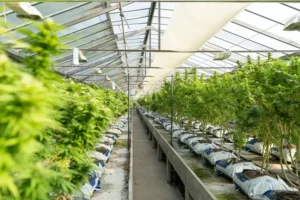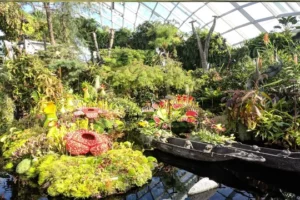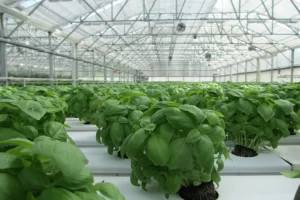A Unique Approach to Sustainable Farming, In today’s rapidly changing world, innovative ideas are emerging to address the challenges of food production and sustainability. One such concept that has gained attention is the idea of a “Greenhouse on a Boat.” This article explores the fascinating concept of cultivating plants within a greenhouse on a boat, revolutionizing the way we think about farming and environmental conservation.
What is a boat garden ?
A boat garden is a unique and creative type of garden that involves repurposing a boat, often a small wooden or metal boat, into a decorative and functional garden space. Instead of being used for its original purpose on water, the boat is filled with soil, plants, and sometimes even small trees or shrubs, creating a miniature garden within the boat structure.
Boat gardens can be placed in various outdoor settings, such as in a backyard, on a patio, or even in a community garden. They offer a whimsical and charming aesthetic, often evoking a sense of nostalgia and adventure. The boat itself acts as a container for the plants, providing a distinctive focal point for the garden.

This type of garden allows for creativity in terms of plant selection and arrangement. People often choose plants that thrive in containers, such as flowers, herbs, succulents, and trailing vines. The choice of plants can also reflect a theme, such as a coastal garden with seashore-inspired plants or a tropical garden with exotic foliage.
Benefits of Boat Garden:
Boat gardens are not only visually appealing but also offer practical benefits. They can be a solution for those with limited space or poor soil quality, as the garden is contained within the boat structure. Additionally, boat gardens can be a fun DIY project for garden enthusiasts who enjoy repurposing objects and exploring creative gardening ideas.
Overall, a boat garden is a delightful way to combine gardening and design, turning a once-functional vessel into a captivating and imaginative green space.
What are greenhouses made of ?
Greenhouses are structures designed to create a controlled environment for plants, allowing them to grow in conditions that might not be naturally available in a particular region or climate.
The materials used to construct greenhouses can vary, but they typically include:
Glass
Traditional greenhouses often have glass panels for their walls and roofs. Glass allows sunlight to enter and trap heat inside, creating a warm environment that promotes plant growth. It provides good visibility and insulation.
Polycarbonate
Panels made of polycarbonate are strong, lightweight, and have good insulating qualities. They may be translucent or transparent, allowing light to pass through while offering some diffusion to lessen exposure to direct sunshine.
Plastic Film
Greenhouses can also be covered with plastic film, which is less expensive than glass or polycarbonate. Plastic film is flexible and easy to work with, but it might need more frequent replacement due to wear and tear from weather conditions.
Acrylic
Acrylic panels offer similar properties to glass but are lighter and less prone to shattering. They are commonly used in smaller, hobbyist greenhouses.
Metal Frames
The framework of a greenhouse is often made from metals such as aluminum or steel. These materials provide structural support and can withstand the weight of the covering materials.
Wood
Some greenhouses use wooden frames for a more natural aesthetic. Treated or rot-resistant wood is preferred to ensure longevity.
Concrete or Brick Base
Greenhouses may have a concrete or brick base to provide stability and thermal mass, helping to regulate temperature fluctuations.
The choice of materials depends on factors like budget, intended use, climate, and personal preferences. Modern greenhouses may use a combination of these materials to optimize cost-effectiveness, durability, insulation, and light transmission.
What are the different types of greenhouses ?
Greenhouses come in various types, each designed to suit specific needs and environmental conditions. Bellow some common types of greenhouses discuss:
Traditional or Even-Span Greenhouse
This is the classic type of greenhouse with a gabled roof that forms an even, sloping angle on both sides. It’s simple and effective for growing a wide range of plants.
Lean-To Greenhouse
This type of greenhouse is built against an existing structure, such as a wall or another building. It’s particularly useful for homeowners with limited space or those who want to utilize the existing structure for support.
A-Frame Greenhouse
Similar to the traditional greenhouse, the A-frame design features a peaked roof that resembles the letter “A.” It provides good height for tall plants and allows for efficient rain and snow runoff.

Quonset or Hoop Greenhouse
This greenhouse has a rounded or semi-circular roof made from arched hoops. It’s cost-effective and easy to construct, making it popular for both commercial and personal use.
Gothic Arch Greenhouse
With a roof that forms a graceful gothic arch, this type offers better snow shedding and a more aesthetically pleasing appearance. It’s commonly used in colder climates.
Sawtooth Greenhouse
The roof of this greenhouse consists of multiple vertical sections, resembling a saw blade. It allows for better control of ventilation and shading.
Dome Greenhouse
As the name suggests, this type features a dome-shaped roof. It’s often used for ornamental plants and can create a unique visual impact.
Geodesic Greenhouse
Inspired by geodesic dome structures, these greenhouses have interconnected triangular panels that form a spherical or semi-spherical shape. They offer great strength and energy efficiency.
Multi-Span or Venlo Greenhouse
This commercial-grade greenhouse consists of multiple interconnected sections, often with a gabled roof. It’s well-suited for large-scale agricultural production.
Pit Greenhouse
Also known as an underground greenhouse, this type is partially buried in the ground, which helps regulate temperature and provides natural insulation.
Shade House or Screen House
While not a traditional greenhouse, these structures use shade cloth to create a controlled environment for plants that need protection from excessive sunlight, wind, or pests.
Cold Frame
This is a simple, unheated structure with a transparent cover. It’s used to extend the growing season for hardy plants or to start seedlings early in the spring.
These are just a few examples of the diverse types of greenhouses available. The choice of greenhouse depends on factors such as the climate, available space, budget, and the specific plants you intend to grow.
The Greenhouse on a Boat Concept
A Fusion of Agriculture and Aquaculture
The concept of a greenhouse on a boat brings together two crucial aspects of sustainable living, agriculture and aquaculture. It leverages the synergy between plant cultivation and fish farming, creating a closed-loop system where the waste produced by fish provides nutrients for plants, and the plants, in turn, purify the water for the fish. This symbiotic relationship mimics natural ecosystems and maximizes resource utilization.
Addressing Land Scarcity and Population Growth
As urbanization accelerates and available land for traditional farming dwindles, the greenhouse boat concept offers a promising solution. By utilizing underutilized water bodies like rivers, lakes, and coastal areas, this approach bypasses the challenges posed by limited land availability. Moreover, with the global population projected to increase, innovative solutions like greenhouse boats could play a vital role in securing our future food supply.
Design and Architecture of the Greenhouse Boat
Incorporating Hydroponics and Aquaponics Systems
The heart of the greenhouse boat lies in its innovative cultivation methods. Hydroponics, a soil-less growing technique, and aquaponics, a combination of aquaculture and hydroponics, are employed. These systems not only maximize space utilization but also ensure efficient use of water and nutrients. Plants thrive in nutrient-rich water, while fish benefit from the purifying effects of the plants’ roots.

Energy Efficiency and Sustainable Practices
Greenhouse boats are designed with sustainability in mind. Solar panels harness the sun’s energy, powering the boat’s systems and reducing its carbon footprint. Rainwater harvesting is employed to minimize reliance on external water sources. Additionally, composting and waste management practices contribute to a circular economy within the boat, minimizing waste and maximizing resource efficiency.
Advantages of the Greenhouse Boat
Mobility and Flexibility
One of the standout features of greenhouse boats is their mobility. Unlike traditional farms, these floating structures can be relocated as needed, allowing farmers to respond to changing market demands or environmental conditions. This mobility also extends the reach of fresh produce to areas lacking arable land, improving food access in remote or underserved communities.
Reduced Water Usage and Environmental Impact
Water scarcity is a pressing concern globally, and agriculture is a major contributor to water consumption. Greenhouse boats address this issue by using water more efficiently. The closed-loop systems drastically reduce water wastage, and the controlled environment minimizes the need for pesticides and fertilizers, decreasing the environmental impact associated with conventional farming practices.
Challenges and Solutions
Adapting to Changing Weather and Sea Conditions
Operating a greenhouse on a boat poses challenges related to changing weather patterns and sea conditions. Storms, high waves, and varying temperatures can impact plant growth and fish health. To mitigate these challenges, advanced weather monitoring systems and stabilizing technologies are employed. Additionally, modular designs allow for flexibility in response to adverse conditions.
Nutrient Management and Waste Utilization
Maintaining the delicate balance between fish waste and plant nutrients is crucial. Over time, excess nutrients can accumulate in the water, leading to imbalances. To address this, greenhouse boat systems incorporate sensors and automated controls to monitor nutrient levels. Moreover, excess waste is managed through composting and innovative waste-to-energy technologies.
Applications and Impact
Urban Farming and Food Security
Greenhouse boats hold immense potential for urban farming. By utilizing water bodies within cities, they bring agriculture closer to consumers, reducing transportation costs and emissions. This proximity also enhances food security by creating localized sources of fresh produce, reducing reliance on distant farms vulnerable to supply chain disruptions.
Educational and Research Opportunities
These floating ecosystems provide valuable educational opportunities. Schools and research institutions can use greenhouse boats as platforms for hands-on learning about sustainable agriculture, biology, and environmental science. By engaging with these innovative setups, the next generation of scientists and farmers can be inspired to develop even more groundbreaking solutions.
Case Studies: Successful Greenhouse Boats
Floating Gardens in Urban Centers
In cities like Amsterdam and Bangkok, floating gardens have become a reality. These greenhouse boats not only contribute to food production but also enhance the aesthetic value of urban water bodies. They serve as hubs for community engagement, fostering a sense of ownership and connection among residents.
Remote Coastal Communities
Greenhouse boats are making a significant impact in remote coastal areas with limited access to arable land. These communities often face challenges in obtaining fresh, nutritious food. By introducing greenhouse boats, these regions can achieve food self-sufficiency and strengthen local economies.
The Future Potential
Collaborative Efforts and Technological Advancements
The future of greenhouse boats lies in collaboration and innovation. Governments, researchers, and private enterprises need to join forces to refine designs, enhance technologies, and scale up operations. Advancements in automation, data analytics, and renewable energy integration will further optimize the performance of these floating farms.

Integration with Renewable Energy Sources
To achieve greater sustainability, future greenhouse boats may integrate additional renewable energy sources. Wind turbines and wave energy converters could supplement solar power, ensuring consistent energy supply even in less sunny conditions. This convergence of green technologies creates synergies that enhance the overall ecological footprint of these systems.
Environmental Considerations
Minimizing Disruptions to Marine Ecosystems
While greenhouse boats offer substantial benefits, their implementation must be mindful of marine ecosystems. Proper environmental impact assessments are essential to ensure that the introduction of these structures does not disrupt native species.
FAQs:
What is a boat’s greenhouse?
Greenhouse on a Boat is a creative idea that allows sustainable farming to occur while floating on the ocean by fusing a fully operational greenhouse with a boat.
How Does a Boat Greenhouse Operate?
The boat has a custom made greenhouse framework that creates the perfect atmosphere for plant growth. It uses nutrient-rich water and hydroponic or aquaponic systems to grow crops without the need for soil.
What Advantages Does a Boat Have with a Greenhouse?
Many benefits come with having a greenhouse on a boat, such as less land needed, year-round crop production, low water usage, and the potential to bring fresh vegetables closer to cities.
Is it possible to cultivate various crops in a greenhouse on a boat?
Yes, a variety of crops, including herbs, leafy greens, vegetables, and even certain fruits, can be grown in a greenhouse aboard a boat. Because of the system’s flexibility, farmers can modify their crop choices in response to seasonal variations and market demand.
Is a greenhouse on a boat a sustainable practice?
Of course! Sustainable agricultural methods that lessen their impact on the environment and carbon emissions are promoted by Greenhouse on a Boat by using hydroponics or aquaponics techniques and minimizing the usage of pesticides.
How do you deal with difficulties such as weather when cruising at sea?
The sophisticated climate control systems built into Greenhouse on a Boat adjust the structure’s humidity, temperature, and lighting. This guarantees ideal growth conditions independent of outside meteorological circumstances.
Can people participate in projects like Greenhouse on a Boat?
Sure, we provide chances for people to get involved in our Greenhouse on a Boat projects through partnerships, education programs, and volunteer work. Watch this space for details on how you may become involved!
Is it intended to take the idea of Greenhouse on a Boat worldwide?
Our aspirations for global expansion are high! In order to bring Greenhouse on a Boat to new places and promote sustainable agricultural methods all around the world, our team is actively looking into possible collaborations and partnerships.
Final Thoughts
The inventive idea of a floating greenhouse presents a distinctive and environmentally friendly method of farming. This mobile greenhouse can supply fresh vegetables to both urban regions and remote areas by combining hydroponic technology with renewable energy sources. It not only addresses the problem of food scarcity, but it also lessens the carbon footprint left by conventional farming practices. We can picture a day in the future when floating greenhouses are a familiar sight on our waterways, adding to a more robust and sustainable food system, with more study and funding put into this idea. It is imperative that we back programs like this that put global food security and environmental responsibility first.